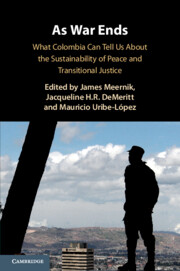Book contents
- As War Ends
- As War Ends
- Copyright page
- Contents
- Contributors
- Acknowledgments
- Introduction
- 1 The Complexity of the Organizational Design for Implementation of a Peace Accord
- 2 Violence, Grassroots Pressure, and Civil War Peace Processes
- 3 Land, Violence, and the Colombian Peace Process
- 4 Determinants of State Strength and Capacity
- 5 The Threat of Organized Crime in Post-Conflict Colombia
- 6 Violence after Peace
- 7 Two Emblematic Peacebuilding Initiatives in Antioquia
- 8 From Counterinsurgency to Peacebuilding
- 9 Transitional Justice in the Colombian Final Accord
- 10 The Comprehensive System of Truth, Justice, Reparation, and Non-Repetition
- 11 Una Tierra Inexplorada
- 12 Leading the Public to Peace
- 13 Securing the Peace and Promoting Human Rights in Post-Accord Colombia
- 14 Achieving an Unpopular Balance
- 15 Countering Violent Extremism through Narrative Intervention
- 16 Geographies of Truth in the Colombian Transitional Justice Process
- 17 Conclusion
- Index
- References
15 - Countering Violent Extremism through Narrative Intervention
For a Decentering of the Local Turn in Peacebuilding
Published online by Cambridge University Press: 18 July 2019
- As War Ends
- As War Ends
- Copyright page
- Contents
- Contributors
- Acknowledgments
- Introduction
- 1 The Complexity of the Organizational Design for Implementation of a Peace Accord
- 2 Violence, Grassroots Pressure, and Civil War Peace Processes
- 3 Land, Violence, and the Colombian Peace Process
- 4 Determinants of State Strength and Capacity
- 5 The Threat of Organized Crime in Post-Conflict Colombia
- 6 Violence after Peace
- 7 Two Emblematic Peacebuilding Initiatives in Antioquia
- 8 From Counterinsurgency to Peacebuilding
- 9 Transitional Justice in the Colombian Final Accord
- 10 The Comprehensive System of Truth, Justice, Reparation, and Non-Repetition
- 11 Una Tierra Inexplorada
- 12 Leading the Public to Peace
- 13 Securing the Peace and Promoting Human Rights in Post-Accord Colombia
- 14 Achieving an Unpopular Balance
- 15 Countering Violent Extremism through Narrative Intervention
- 16 Geographies of Truth in the Colombian Transitional Justice Process
- 17 Conclusion
- Index
- References
Summary
Since the 1960s Colombian public universities have served as a stage for the violent enactment of dissent and resistance and have become one of the many theaters of the internal armed conflict. The images of armed hooded militias parading on university campuses, throwing explosives at the police, destroying public property, or interrupting the regular flow of academic life became part of the routine landscape of many public universities.
- Type
- Chapter
- Information
- As War EndsWhat Colombia Can Tell Us About the Sustainability of Peace and Transitional Justice, pp. 346 - 365Publisher: Cambridge University PressPrint publication year: 2019



